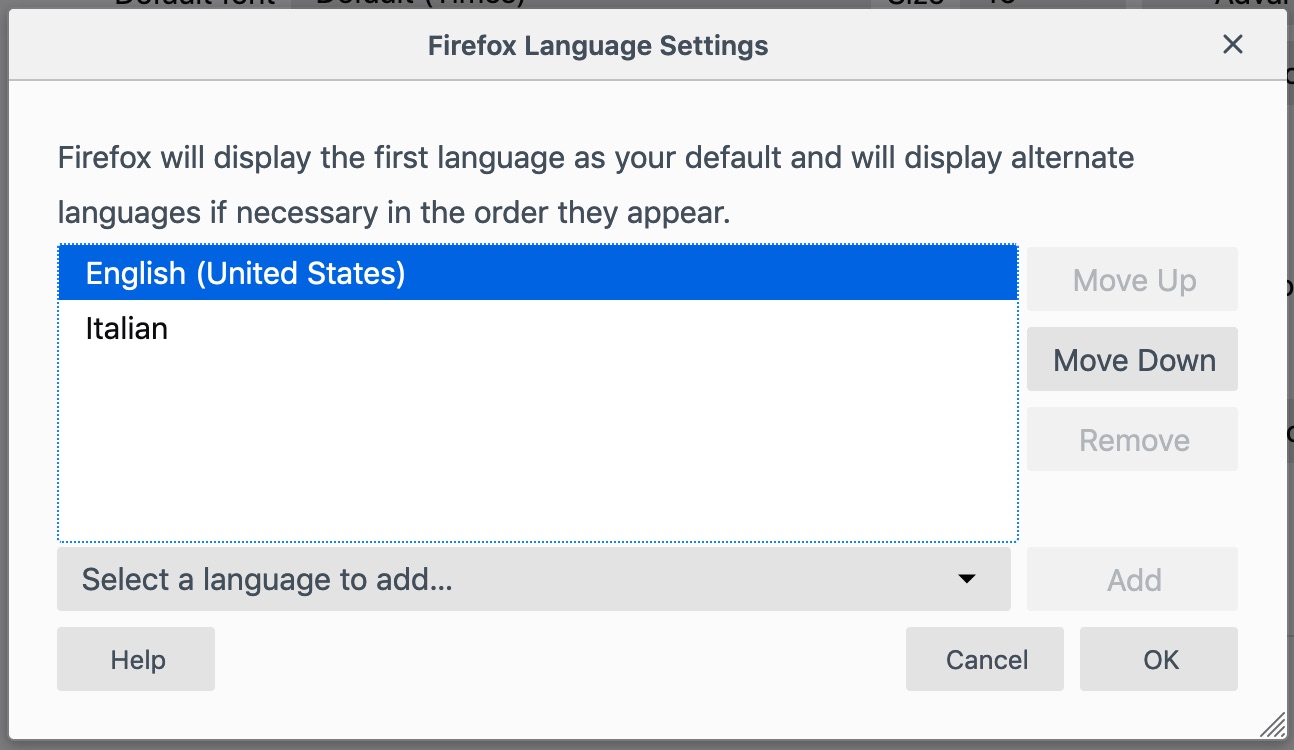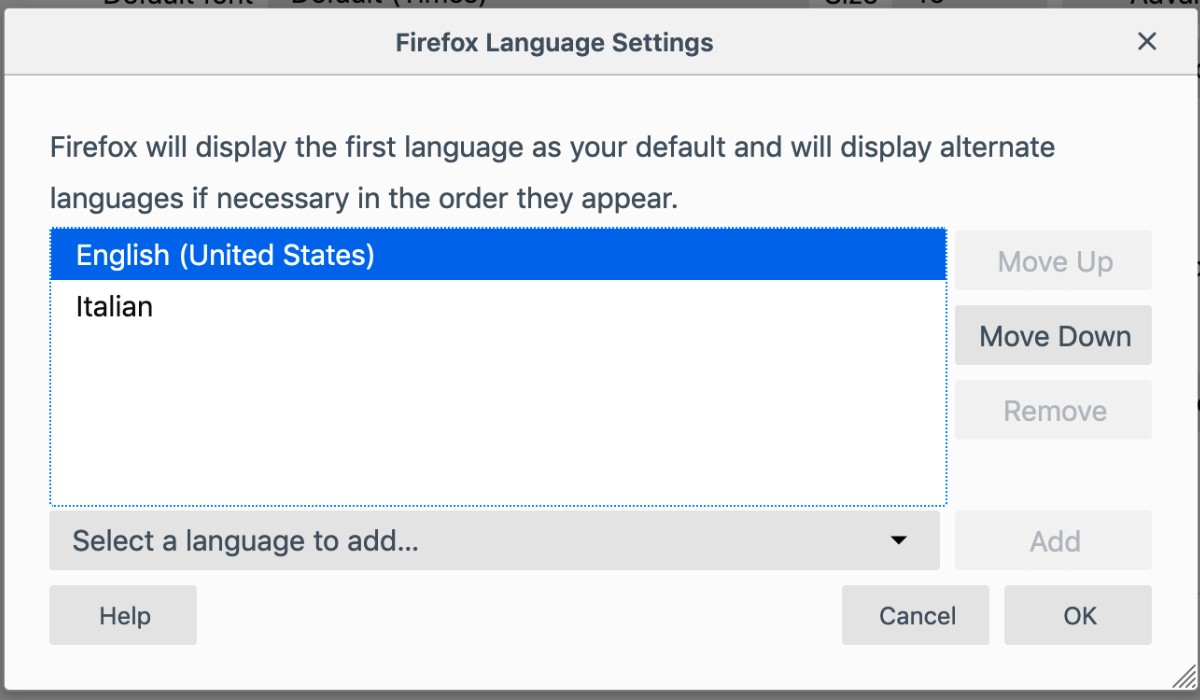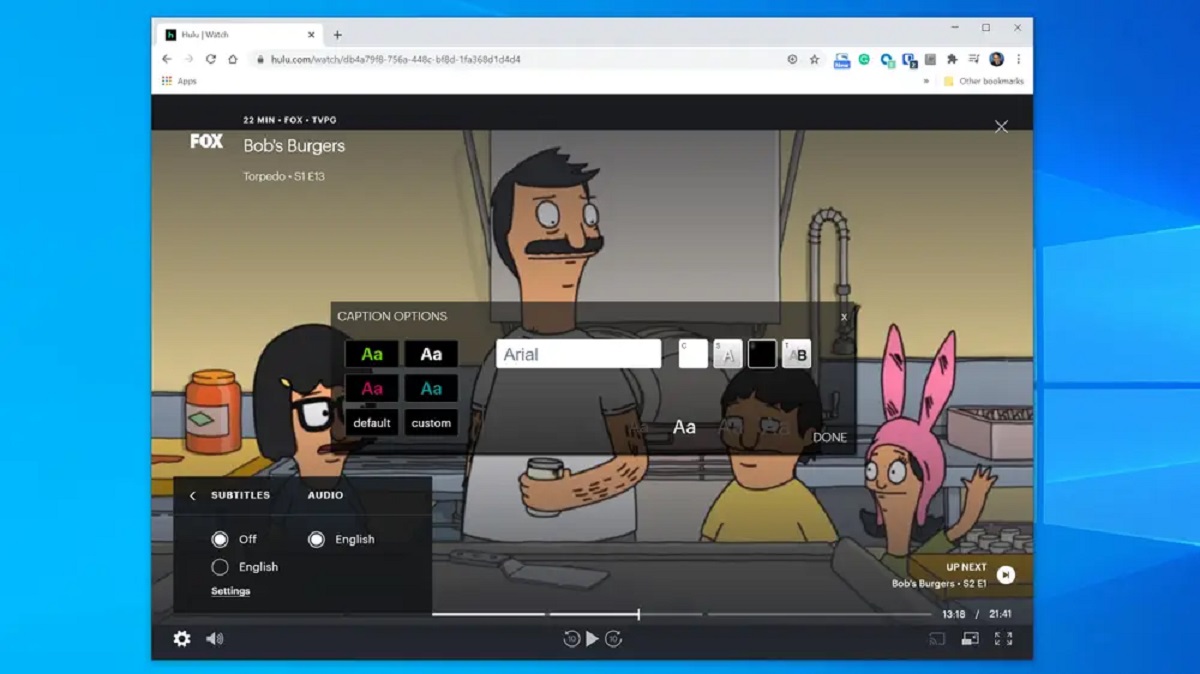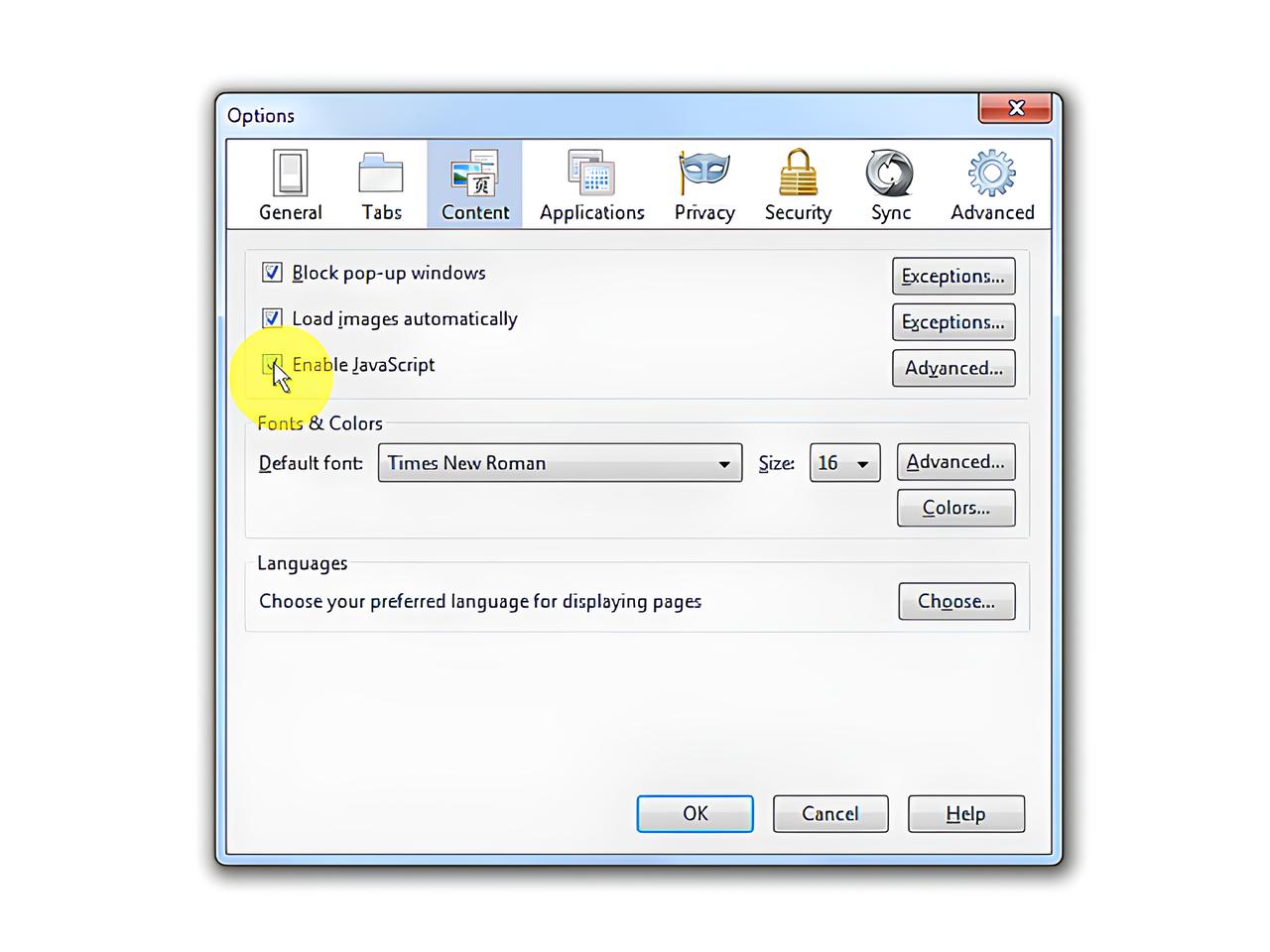Introduction
Mozilla Firefox is a popular web browser known for its user-friendly interface and customizable features. While Firefox is available in multiple languages to cater to a diverse global audience, you may find yourself needing to change the browser's language to English for a more comfortable browsing experience. Whether you're a native English speaker or simply prefer navigating the web in English, adjusting the language settings in Firefox is a straightforward process that can be completed in just a few simple steps.
In this guide, we will walk you through the process of changing the language to English in Mozilla Firefox. By following these steps, you can ensure that the browser's interface, menus, and settings are all displayed in English, allowing for seamless navigation and a more intuitive browsing experience. Whether you're a seasoned Firefox user or just getting started with the browser, customizing the language settings to English can enhance your overall browsing experience and make it easier to access the features and tools within the browser.
So, let's dive into the steps to change the language to English in Mozilla Firefox and ensure that you can enjoy a more familiar and comfortable browsing experience. Whether you're using Firefox on a Windows, Mac, or Linux operating system, the process for changing the language settings remains consistent, making it easy to follow along regardless of your device. Let's get started!
Step 1: Open Mozilla Firefox
To begin the process of changing the language to English in Mozilla Firefox, you'll first need to open the browser on your device. Whether you're using a Windows PC, a Mac, or a Linux-based system, the steps for launching Firefox are consistent across different platforms.
If you're using a Windows computer, you can typically find the Mozilla Firefox shortcut on your desktop or in the taskbar. Simply double-click on the Firefox icon to open the browser. Alternatively, you can also access Firefox by clicking on the Windows Start menu, locating the Firefox application, and selecting it to launch the browser.
For Mac users, you can open Mozilla Firefox by locating the application in the Applications folder. Once you've located Firefox, double-click on the icon to launch the browser. Additionally, you can also access Firefox from the Dock by clicking on the Firefox icon.
If you're using a Linux-based system, you can open Mozilla Firefox through the application menu. Simply navigate to the relevant category, such as "Internet" or "Web Browser," and select Mozilla Firefox to launch the browser.
Regardless of your operating system, once you've successfully opened Mozilla Firefox, you're ready to proceed to the next step in the process of changing the language settings to English.
By following these simple steps, you can easily open Mozilla Firefox on your device, setting the stage for customizing the language settings to ensure a more comfortable and familiar browsing experience. With Firefox now open and ready for use, you're one step closer to adjusting the language settings to English, allowing for seamless navigation and an enhanced browsing experience.
Step 2: Click on the Menu Button
Upon opening Mozilla Firefox, the next step in changing the language to English involves accessing the browser's menu. The menu button is a central hub for various browser functions, including accessing settings, add-ons, and customization options. By clicking on the menu button, you can navigate to the specific area where language settings are located, allowing you to proceed with the language customization process.
Located in the upper-right corner of the Firefox window, the menu button is represented by three horizontal lines, symbolizing a dropdown menu. Clicking on this button triggers the display of a dropdown menu containing a range of options and features. The menu button serves as a gateway to accessing essential browser functions, making it a pivotal element in customizing the language settings to English.
To click on the menu button, position your cursor over the three horizontal lines in the upper-right corner of the Firefox window. Once your cursor is positioned over the menu button, click the left mouse button or tap the trackpad to activate the dropdown menu. This action prompts the menu to expand, revealing a list of options that enable you to navigate through different areas of the browser.
By clicking on the menu button, you gain access to a plethora of features and settings within Mozilla Firefox, empowering you to tailor the browser to your preferences. From managing bookmarks to accessing browser tools and options, the menu button serves as a gateway to a wealth of functionalities, including the language settings that you'll soon explore.
With the menu button clicked and the dropdown menu displayed, you're now ready to proceed to the next step in customizing the language settings to English. By navigating through the menu options, you'll soon arrive at the specific area where language settings are housed, allowing you to seamlessly transition to the subsequent steps in the language customization process.
In summary, clicking on the menu button in Mozilla Firefox is a pivotal step that sets the stage for accessing essential browser functions, including language settings. By interacting with the menu button, you gain entry to a world of customization options, enabling you to tailor the browser to your preferences and ensure a more intuitive and personalized browsing experience.
Step 3: Select Options
After clicking on the menu button in Mozilla Firefox, the next crucial step in customizing the language settings to English involves selecting the "Options" menu. The "Options" menu serves as a gateway to a wide array of browser settings and preferences, allowing users to fine-tune their browsing experience according to their individual needs and preferences.
Upon clicking the menu button, you will notice a series of options displayed within the dropdown menu. Among these options, you will find "Options" represented by a gear or cogwheel icon, typically located towards the bottom of the dropdown menu. To proceed with customizing the language settings, you need to position your cursor over the "Options" menu item and click the left mouse button or tap the trackpad to select it.
By selecting the "Options" menu, you gain access to a comprehensive settings panel that empowers you to personalize various aspects of Mozilla Firefox. This includes customizing privacy and security settings, managing add-ons and extensions, and crucially, adjusting language preferences to ensure a more comfortable browsing experience in English.
Upon selecting the "Options" menu, a new tab or window will open within the Firefox interface, presenting you with a range of categories and settings to explore. Among these categories, you will find "General," which encompasses fundamental browser settings, including language preferences.
Within the "General" category, you will find the "Language and Appearance" section, where you can manage language settings and choose your preferred language for displaying Firefox's interface, menus, and settings. Here, you can add or remove languages, set the preferred language order, and ensure that English is selected as the primary language for your browsing experience.
By navigating to the "Language and Appearance" section within the "Options" menu, you can seamlessly transition to the next step in the process of customizing the language settings to English. This pivotal stage empowers you to fine-tune the language preferences within Firefox, ensuring that the browser's interface and content are presented in English, aligning with your language preferences and enhancing your overall browsing experience.
In summary, selecting the "Options" menu within Mozilla Firefox is a crucial step that grants you access to a wealth of browser settings, including language preferences. By navigating to the "Language and Appearance" section within the "Options" menu, you can seamlessly progress to the subsequent steps in customizing the language settings to English, ensuring a more intuitive and personalized browsing experience tailored to your language preferences.
Step 4: Go to Language Settings
After accessing the "Options" menu in Mozilla Firefox, the next pivotal step in customizing the language settings to English involves navigating to the "Language and Appearance" section within the browser's settings. This critical stage empowers you to fine-tune the language preferences, ensuring that the browser's interface, menus, and content are displayed in English, aligning with your language preferences and enhancing your overall browsing experience.
Upon selecting the "Options" menu, you will be presented with a comprehensive settings panel, typically displayed in a new tab or window within the Firefox interface. Within this panel, you will find the "General" category, which encompasses fundamental browser settings, including language preferences.
To proceed to the language settings, you need to navigate to the "Language and Appearance" section within the "General" category. This section serves as the central hub for managing language preferences, allowing you to customize the language settings to ensure a more comfortable and familiar browsing experience in English.
Within the "Language and Appearance" section, you will encounter the "Choose your preferred language for displaying pages" option. This pivotal setting enables you to select English as the primary language for displaying Firefox's interface, menus, and content. By clicking on the "Choose…" button or a similar action associated with this setting, you can access a menu that presents a list of available languages.
In this menu, you can add English as a preferred language if it's not already listed, or adjust the language order to prioritize English as the primary language for your browsing experience. This step is crucial in ensuring that the browser's interface and content are presented in English, aligning with your language preferences and enhancing your overall browsing experience.
By navigating to the "Language and Appearance" section and fine-tuning the language preferences within the "Options" menu, you can seamlessly transition to the subsequent steps in the process of customizing the language settings to English. This pivotal stage empowers you to tailor the language settings within Firefox, ensuring a more intuitive and personalized browsing experience aligned with your language preferences.
In summary, navigating to the "Language and Appearance" section within the "Options" menu is a crucial step that enables you to fine-tune the language preferences, ensuring that the browser's interface and content are displayed in English. By customizing the language settings to prioritize English, you can enhance your overall browsing experience and ensure a more comfortable and familiar interface within Mozilla Firefox.
Step 5: Choose English as the Preferred Language
Within the "Language and Appearance" section of the "Options" menu in Mozilla Firefox, the pivotal step of choosing English as the preferred language is essential for ensuring that the browser's interface, menus, and content are displayed in English, aligning with your language preferences and enhancing your overall browsing experience.
To select English as the preferred language, you need to navigate to the "Choose your preferred language for displaying pages" option within the "Language and Appearance" section. By clicking on the "Choose…" button associated with this setting, you can access a menu that presents a list of available languages.
In this menu, you can add English as a preferred language if it's not already listed, or adjust the language order to prioritize English as the primary language for your browsing experience. By selecting English as the preferred language, you ensure that the browser's interface and content are presented in English, aligning with your language preferences and enhancing your overall browsing experience.
By prioritizing English as the primary language within Firefox, you can seamlessly navigate through the browser's interface, menus, and settings with ease, as they will be displayed in English, providing a more intuitive and familiar browsing experience. Whether you're accessing browser tools, managing bookmarks, or exploring web content, having the interface and content presented in English can significantly enhance your overall browsing experience.
Choosing English as the preferred language within Mozilla Firefox empowers you to tailor the browser to your language preferences, ensuring that you can comfortably navigate the web in English. This customization allows for a seamless and personalized browsing experience, aligning with your language preferences and making it easier to access the features and tools within the browser.
In summary, by selecting English as the preferred language within the "Language and Appearance" section of the "Options" menu, you can ensure that the browser's interface, menus, and content are displayed in English, aligning with your language preferences and enhancing your overall browsing experience.
Step 6: Restart Firefox to Apply the Changes
Once you have customized the language settings to English within Mozilla Firefox, the final step involves restarting the browser to apply the changes. Restarting Firefox is essential to ensure that the language preferences and settings take effect, allowing for a seamless transition to an interface, menus, and content displayed in English.
To restart Firefox, you can follow a simple process to close and relaunch the browser. If you have multiple tabs or windows open within Firefox, it's important to save any ongoing work or bookmark important pages before proceeding with the restart. Once you've ensured that your browsing session is ready to be refreshed, you can proceed with the following steps to restart Firefox:
-
Close Firefox: To initiate the restart process, you need to close the Firefox browser window. Depending on your operating system, you can typically click on the "X" button in the upper-right corner of the Firefox window to close the browser. Alternatively, you can use the keyboard shortcut Ctrl + Q (Command + Q on Mac) to quickly exit the browser.
-
Relaunch Firefox: After closing the browser, you can relaunch Firefox by clicking on the desktop shortcut, taskbar icon, or application menu entry, depending on your operating system. Upon relaunching Firefox, the browser will reopen with the updated language settings applied, presenting the interface, menus, and content in English as per your preferences.
By restarting Firefox, you ensure that the changes made to the language settings are fully implemented, providing you with a more intuitive and familiar browsing experience in English. Whether you're navigating through browser tabs, accessing settings, or exploring web content, the interface and menus will now be displayed in English, aligning with your language preferences and enhancing your overall browsing experience.
In summary, restarting Firefox is a crucial step in the process of customizing the language settings to English, allowing the changes to take effect and ensuring a seamless transition to an interface presented in your preferred language. By following the simple steps to close and relaunch the browser, you can apply the updated language settings and enjoy a more comfortable and familiar browsing experience within Mozilla Firefox.
Conclusion
In conclusion, customizing the language settings to English in Mozilla Firefox is a simple yet impactful process that can significantly enhance your browsing experience. By following the step-by-step guide outlined in this article, you can seamlessly transition to an interface, menus, and content displayed in English, aligning with your language preferences and ensuring a more intuitive and personalized browsing experience.
The journey to changing the language settings begins with opening Mozilla Firefox on your device, regardless of whether you're using a Windows PC, a Mac, or a Linux-based system. Once the browser is open, clicking on the menu button serves as the gateway to accessing essential browser functions, leading you to the pivotal "Options" menu where language settings are housed.
Navigating to the "Language and Appearance" section within the "Options" menu empowers you to fine-tune the language preferences, ensuring that the browser's interface and content are presented in English. By choosing English as the preferred language and restarting Firefox to apply the changes, you can seamlessly transition to a more comfortable and familiar browsing experience tailored to your language preferences.
Customizing the language settings to English in Mozilla Firefox not only ensures that the browser's interface and menus are displayed in your preferred language but also facilitates easier navigation and access to browser features and tools. Whether you're managing bookmarks, exploring web content, or utilizing browser tools, having the interface presented in English can significantly enhance your overall browsing experience.
By prioritizing English as the primary language within Firefox, you can navigate the web with ease, benefiting from a more intuitive and familiar browsing experience. This customization allows for seamless navigation through the browser's interface and content, aligning with your language preferences and making it easier to access the features and tools within the browser.
In essence, customizing the language settings to English in Mozilla Firefox empowers you to tailor the browser to your language preferences, ensuring a more comfortable and personalized browsing experience. By following the simple steps outlined in this guide, you can seamlessly transition to an interface, menus, and content displayed in English, enhancing your overall browsing experience within Mozilla Firefox.

























